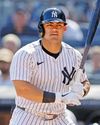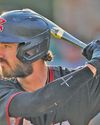
There will be 450 fewer roster spots in the domestic minor leagues in 2024 than there were a year ago.
It will be easy to miss the change. Teams will still field five U.S. minor league teams, one Rookie complex affiliate and four full-season clubs. The change means that teams will go from having 36 to 33 rosterable
players per team. Since Triple-A and Double-A teams are limited to 28 active players and Class A clubs are limited to 30, how big of a deal is it to have the number of non-active players reduced?
For a lot of coaches and front office officials, it’s huge. “All 30 farm directors, the first thing and last thing we do each day is
(figure out) ‘do we have enough bodies?’ This is going to make that part of the day tougher,” one farm director said. “You want to make sure you’re covered every night. It will get tougher.”
MLB this year reduced the number of active minor league players an organization can have under contract from 180 to 165. The 15-player reduction applies to organizations’ domestic minor league rosters and does not include Dominican Summer League players.
Even the old limit of 180 players, which was enacted in 2021, was a dramatic change from the previous model. Before the pandemic, an organization could effectively roster as many minor league players as it wanted by adding affiliates—and thus roster spots—to its farm system.
The Yankees in 2019, for example, had four minor league clubs below the full-season level: two Rookie-level Gulf Coast League affiliates, one in the Rookie-advanced Appalachian League and a fourth in the short-season New York-Penn League. Today, the Yankees are permitted only one such domestic short-season club, their Florida Complex League affiliate.
This story is from the March/April 2024 edition of Baseball America.
Start your 7-day Magzter GOLD free trial to access thousands of curated premium stories, and 9,000+ magazines and newspapers.
Already a subscriber ? Sign In
This story is from the March/April 2024 edition of Baseball America.
Start your 7-day Magzter GOLD free trial to access thousands of curated premium stories, and 9,000+ magazines and newspapers.
Already a subscriber? Sign In

THE SERVICE TIME CONUNDRUM
MLB’s byzantine service time rules cloud rookie status and now PPI eligibility

LUIS TIANT WAS MLB'S MOST SUCCESSFUL CUBAN PITCHER
On a scouting trip to Cuba in 1957, Bobby Avila discovered 16-year-old righthander Luis Tiant on the island's Juvenile League all-star team.

ORGANIZATION REPORT
Outfielder Heston Kjerstad's career has been unique, to say the least.

TOP 10 NL EAST
From the moment Thomas White stepped on a high school mound, he was viewed as the top lefthander available in the 2023 draft.

PREPARATION PAYS OFF
lowa politician J.D. Scholten makes a surprising return to pro ball at age 44

MAKING THE GRADE
Assessing the future value of graduated National League prospects

TOP 10 NL WEST
Even in high school, Bryce Eldridge could hit the ball a mile. The 6-foot-7 righthander could also touch 96 mph off the mound.

Wood Has Towering Upside- Nationals rookie James Wood also stands 6-foot-7 and also has game-changing power.
Aaron Judge and Oneil Cruz are 6-foot7 sluggers who stand out for their power in this year’s MLB Best Tools voting. Wood spent half of this season with Triple-A Rochester before making his MLB debut on July 1. While he was in the International League, he captured managers’ attention. Wood unanimously won Best Power Prospect and also claimed Most Exciting Player in a survey of league skippers. Wood hit .353/.463/.595 with 10 home runs in 52 games for Rochester. His .242 isolated slugging was the best for a player 21 or younger at Triple-A this season.

ROAD BLOCK?
Scholarship expansion puts mid-majors at a major disadvantage on the road to Omaha

ROYALS REVIVAL
A revamped and rejuvenated farm system has Kansas City ready to rebound